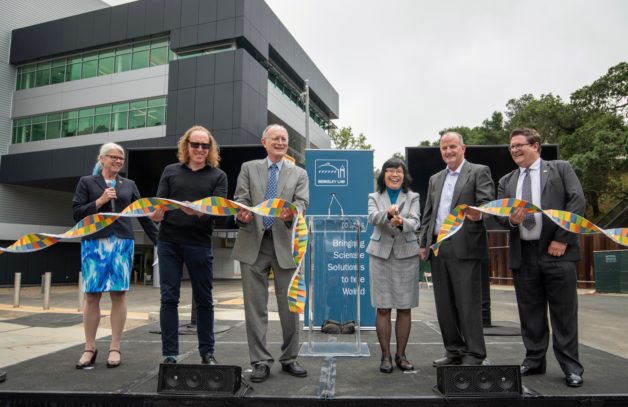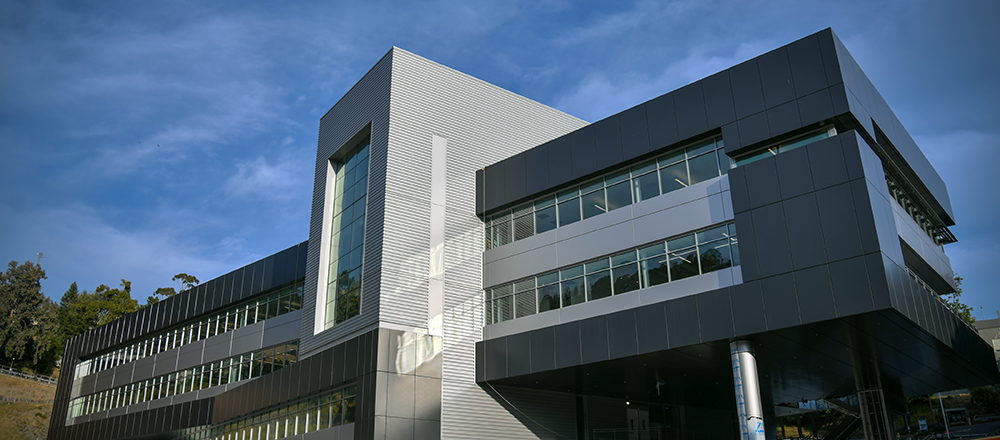
Biosciences Area Associate Lab Director Mary Maxon caps off the Integrative Genomics Building dedication festivities by leading the ceremonial “snipping” of a double-helix-inspired ribbon. From left to right: Mary Maxon; Sean Simpson, CEO and co-founder of LanzaTech; Michael Witherell, Director of Berkeley Lab; Sharlene Weatherwax, Associate Director of Science for Biological and Environmental Research, DOE Office of Science; Marc Jones, Director of the Office of Field Safety, Security, and Infrastructure, DOE Office of Science; and Nigel Mouncey, Director of the Joint Genome Institute. (Credit: Thor Swift/Berkeley Lab)
Marking a step forward in Berkeley Lab’s vision to expand the footprint of the biological and environmental sciences on the main campus, the Integrative Genomics Building (IGB) was dedicated today during a two-hour ceremony that culminated in the cutting of a double helix ribbon representing DNA. By uniting leading experts and world-class technologies under one roof, the IGB will help transform plant and microbial genomics research into solutions for today’s most pressing environmental and energy issues.
The state-of-the-art building will be the new home of the Joint Genome Institute, a Department of Energy (DOE) Office of Science user facility that has pioneered genomic investigations since the landmark Human Genome Project; and the DOE Systems Biology Knowledgebase (KBase), a large-scale bioinformatics software and data platform that supports the global genomics research community. The IGB enables JGI and KBase scientists to work side-by-side and embeds them in a diverse research community that includes other world-class user facilities such as ESnet, NERSC, and the Advanced Light Source.
“The IGB is the result of a long-planned for integration of the DOE’s Joint Genome Institute and Systems Biology Knowledgebase into the main campus of the Lab,” said Berkeley Lab director Michael Witherell. “We believe that with the strong partnership of JGI and KBase, as well as with the synergies they will find with the Lab’s other national user facilities and researchers, the IGB will be the premier genomics facility in the United States devoted to addressing challenges in bioenergy and environmental stewardship.”

The Integrative Genomics Building at Berkeley Lab. JGI and KBase staff are expected to move in
by October 2019. (Credit: Kelly Owen/Berkeley Lab)
The IGB is located on the site that held Berkeley Lab’s famed Bevatron particle accelerator: a first-of-its-kind facility that enabled huge advances in our understanding of fundamental physics during the 1950s and 1960s, including the discoveries of antiprotons and antineutrons, subatomic resonance states (leading to the quark model) and “strange” particles (the first known example of a lack of symmetry in nature).
The next generation of research that will occur on this storied site is envisioned to expand our knowledge and technological capabilities in functional genomics – the scientific field dedicated to characterizing and quantifying large pools of data relating to genes, proteins, and other biological molecules to explore the activities and dynamics of individual organisms and entire living communities. The new building was funded by the DOE Office of Science.

The double-helix ribbon, created by local high school students. (Credit: Kelly Owen/Berkeley Lab)
“DOE biology has made profound discoveries in how living systems are designed, controlled, and respond to their surroundings,” Sharlene Weatherwax, the Associate Director of Science for Biological and Environmental Research at the DOE Office of Science, said during the dedication. “By understanding these fundamental and adaptive principles, we hope to be able to improve on them or substitute in new capabilities to create new solutions for DOE’s mission – whether for bioenergy or bioproducts production, maintaining a secure and sustainable ecosystem, or to drive a vibrant bioeconomy. [And] at the foundation of our systems-level understanding is genomics.”
The new building – which is expected to be occupied and fully operational by the end of October – consists of nearly 81,000 gross square feet (gsf) of space spread across four stories of laboratories and offices. Designed to prioritize sustainability, the IGB is equipped with low-flow water fixtures, drought-tolerant landscaping, all LED lighting, and uses intelligently placed windows to illuminate naturally as much as possible. In addition, the roof hosts solar panels capable of producing 300 kilowatts of electricity – enough to cover about 10% of the building’s power needs. The building’s interior layout features an array of collaborative spaces – such as breakrooms and huddle rooms – that will stimulate and inspire inclusive and integrative science by JGI, KBase and Berkeley Lab researchers.
“The IGB’s location right here in the heart of Berkeley Lab places us in the center of this amazing scientific and operational ecosystem. Together, we are ensuring our nation is best positioned to harness the genetic potential of the earth,” said Nigel Mouncey, director of JGI.
“About ten years ago, when we started the modernization initiative, there was a vision to bring the biological sciences together in Berkeley, and so now we’re seeing it come to fruition,” said Marc Jones, Director of the Office of Field Safety, Security, and Infrastructure at the DOE Office of Science. Addressing the crowd, Jones added: “I remember when we were doing the Bevatron demolition, that had a rich history – four Nobel prizes. No pressure, Michael! But I am really eager to see the science that comes together here.”
